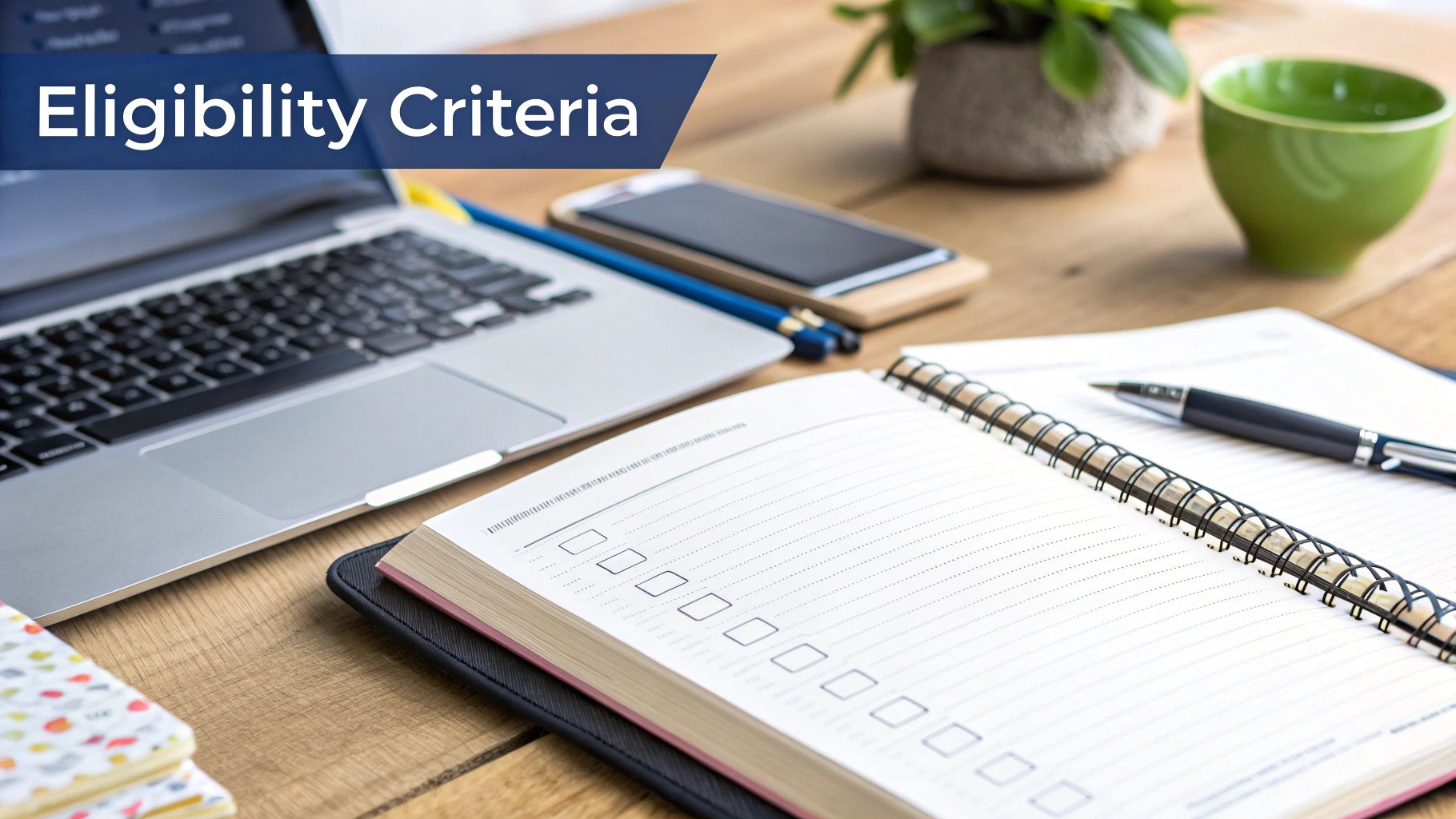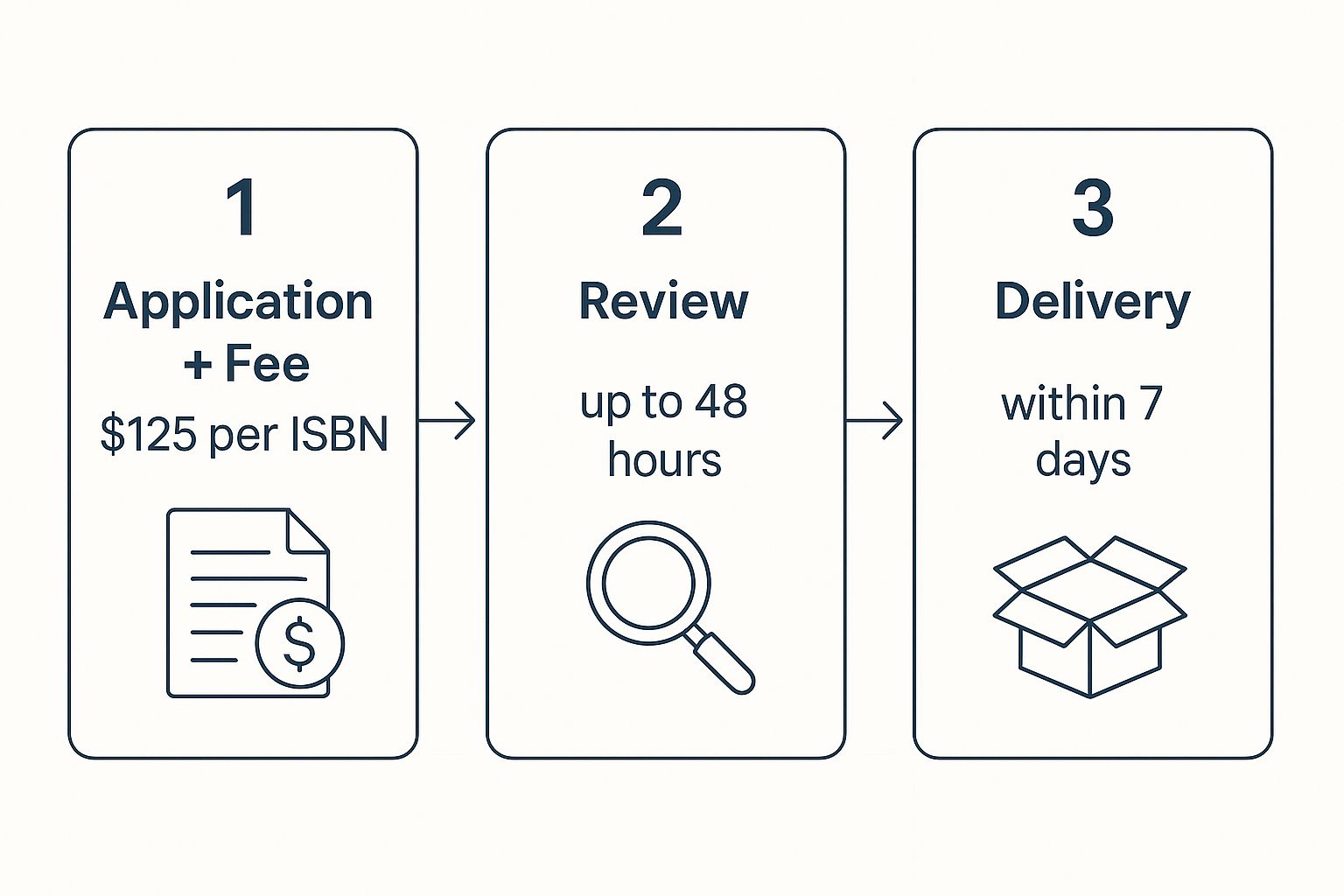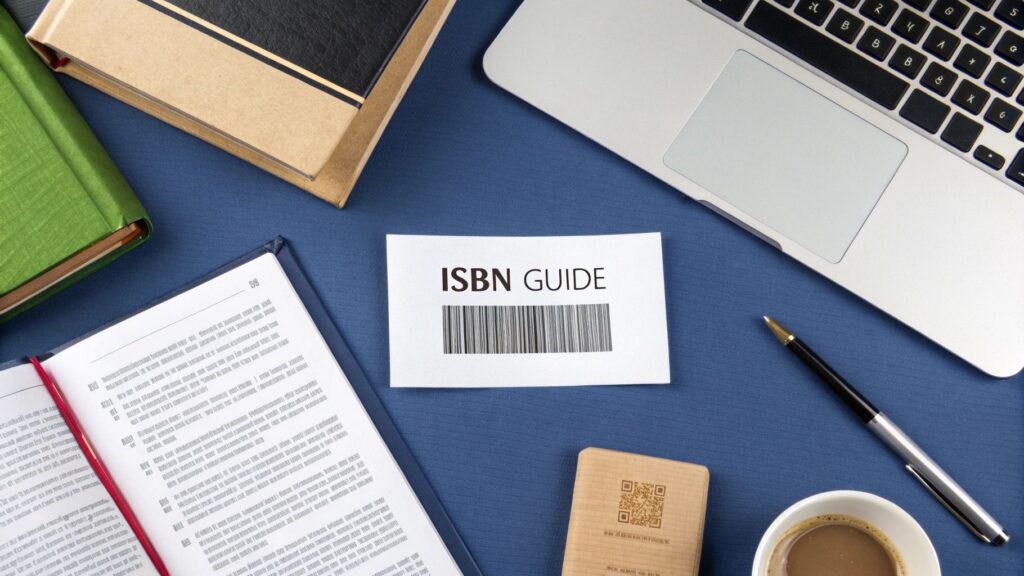So, you’re ready to get your book out into the world. That's fantastic. One of the first official steps you'll take is getting an ISBN. It might sound technical, but it’s actually a straightforward process that solidifies your book as a legitimate product in the marketplace.
The short version is you'll be buying a unique 13-digit code from your country's official ISBN agency. For authors in the United States, that’s Bowker. This little number is what makes your book visible to retailers, distributors, and libraries everywhere.
What's an ISBN, and Why Do I Really Need One?
Before we get into the "how," let's talk about the "why." An International Standard Book Number (ISBN) is, quite simply, your book's unique ID for the entire global book industry. It’s like a fingerprint or a social security number—no two books have the same one.
This 13-digit code is the key that lets everyone in the supply chain, from huge retailers like Amazon down to your neighborhood indie bookstore, track, order, and handle your book properly. If you don't have one, your book is essentially invisible to commercial and library systems.
Yep, Every Format Needs Its Own ISBN
Here's something that trips up a lot of first-time authors: each version of your book needs its own, separate ISBN. Getting this right from the start will save you a world of trouble down the road.
Think of it this way—each format is a distinct product.
- Your paperback edition? It needs an ISBN.
- The hardcover version? It needs a different ISBN.
- Your ebook (like an EPUB or MOBI file)? That gets its own ISBN, too.
- Planning an audiobook? You guessed it—it also requires a unique ISBN.
This separation ensures that when a reader orders a paperback copy, the bookstore's system pulls the correct product, not the hardcover or ebook. It prevents logistical chaos.
The ISBN system kicked off back in 1970 to standardize book identification. With around 2.2 million new books published worldwide in 2021 alone, it’s easy to see why this system is absolutely essential for keeping the industry running. If you're interested in the numbers, you can explore more publishing industry statistics on Wifitalents.
Owning Your Publishing Identity
When it comes down to it, buying your own ISBN is about professionalism and maintaining control over your work. When you purchase the ISBN yourself, you are listed as the publisher.
This is a big deal. It means you have the freedom to print and distribute your book through any channel you choose, now or in the future, without being locked into a single platform's ecosystem. It’s a foundational move that positions your book for commercial success and helps you avoid snags that could limit your reach right out of the gate.
How to Find Your Official National ISBN Agency
Getting an ISBN for your book isn't a global free-for-all. The entire system is organized by country, and you have to go through your nation's designated agency to get your official number. Think of it like getting a driver's license—you can't just go to any office in any country; you have to use the one assigned to where you live.
This is a critical first step. Applying through the correct national body ensures your ISBN is valid and properly registered to you as the publisher.
For Authors in the United States
If you're a US-based author, your path is simple: you need to go to Bowker. They are the one and only official source for ISBNs in the United States.
You might see third-party sellers offering cheap ISBNs online. Be very careful here. Buying from a reseller often means they will be listed as the publisher of record, not you. This can create a tangled mess of ownership and distribution rights down the road. To avoid all that, always buy directly from the source.
Here’s a look at the Bowker homepage, which is your starting point.

As you can see, the site makes it pretty clear where authors and publishers need to go. Heading straight to their "Buy an ISBN" section ensures the number is registered in your name, giving you complete control over your book's future.
For International Authors
For everyone outside the US, the process is conceptually the same, but you'll be dealing with a different agency. Your first task is to identify your country's official ISBN provider.
The entire global ISBN system is built on this network of national agencies. While US authors use Bowker, an author in the UK has to go through the Nielsen ISBN Store. This regional structure is foundational to how the book industry operates. You can dive deeper into how these systems support the book market on Wifitalents.
Here are a few of the major agencies to give you an idea:
- United Kingdom: Nielsen is the official ISBN agency for publishers and authors in the UK and Ireland.
- Canada: Canadian authors have a great perk—Library and Archives Canada provides ISBNs completely free of charge.
- Australia: Down Under, the official source is Thorpe-Bowker.
Don't see your country listed? No problem. The best resource for finding your specific agency is the International ISBN Agency website. They maintain a full global directory of national agencies. A quick search there will point you exactly where you need to go and help you steer clear of any publishing headaches.
Alright, let's talk numbers. The cost of an ISBN is one of those early "welcome to publishing" moments for a lot of authors. It’s more than just a fee; it’s a real investment in your book's future, so you want to get it right from the start.

When you start looking into how to get an ISBN, the price can be a bit of a shock. If you're in the United States, you'll be going through Bowker, and a single ISBN will set you back $125.
That price tag often makes authors pause. It immediately forces you to think strategically about your publishing plans. Are you testing the waters with one book, or are you in this for the long haul?
Single Purchase vs. Bulk Investment
Buying just one ISBN for $125 makes perfect sense if you are absolutely, positively sure you're only publishing one book in a single format. But let's be realistic—most authors I know have bigger ambitions.
Think about it. If you plan to release a paperback, a hardcover, and an ebook version of your masterpiece, you're going to need three different ISBNs right out of the gate. That's $375 if you buy them one at a time. Ouch.
This is where buying in bulk becomes a no-brainer.
The real savings come when you buy ISBNs in blocks. A block of 10 ISBNs from Bowker, for example, costs $295. This drops the price of each individual ISBN to just $29.50. That’s a massive discount—over 75% off the single-purchase price.
Suddenly, the math looks a lot friendlier.
This is a smart long-term move. Even with just one book on the horizon, getting a block of 10 gives you the freedom to publish across multiple formats, release a revised edition down the line, or even cover your next couple of books without having to think twice. It prevents you from paying that premium price over and over again.
For more on building your career, our guide on how to become a published author has plenty of strategic advice like this. A slightly larger upfront investment in your ISBNs can save you a surprising amount of money over time.
Free vs. Paid ISBNs: Which Is Right for You?
So, you're ready to get your book out into the world, and you’ve run into the ISBN question. Many platforms like Amazon's KDP or IngramSpark will offer you a "free" one, which sounds pretty great on the surface. Who doesn't love free? But hold on—this is one of those moments where you need to look past the price tag. The decision you make here will have a surprisingly big impact on your author career.

This whole debate really comes down to a single, critical factor: who is listed as the publisher of record. It’s a detail that’s easy to overlook, but it changes everything.
When you take a free ISBN, the platform providing it becomes the publisher. On Amazon, for instance, your book’s publisher will be listed as "Independently published." But when you buy your own ISBN directly from an official agency, you—or your publishing company—are the publisher. This distinction might seem small, but it's the difference between renting and owning.
The Publisher of Record Matters More Than You Think
Owning your ISBN gives you total control. Think of it as your book's official passport. With your own ISBN, you can print your book anywhere, use any distributor you like, and switch between different platforms or printers without a single hiccup. You're effectively running your own small press.
A free ISBN, however, ties your book to that specific platform. If you use a free ISBN from KDP, that specific version of your book can only be sold on Amazon. Want to get that same print edition into physical bookstores or libraries through a distributor like IngramSpark? You can't. You’d need a completely different ISBN for that channel.
For self-published authors, who accounted for nearly 25% of all new book titles in 2022, getting an ISBN is the gateway to reaching a wider audience. Owning your number from day one keeps all your doors open.
A free ISBN from a platform is like borrowing a license plate. It lets you drive the car, but only on their private roads. Buying your own ISBN is like getting official state plates—it lets you drive anywhere you want, no restrictions.
Deciding what's best for you really comes down to your long-term goals. To help you weigh the pros and cons, let's look at a direct comparison.
Free ISBN vs. Purchased ISBN: A Head-to-Head Comparison
This table breaks down the key differences between using a platform's free ISBN and buying your own. It should give you a clear picture of what you gain—and what you give up—with each choice.
| Feature | Free ISBN (e.g., from KDP) | Purchased ISBN (e.g., from Bowker) |
|---|---|---|
| Publisher of Record | The platform (e.g., "Independently published" via Amazon) | You or your publishing company |
| Cost | Free | Varies by country; in the U.S., a single ISBN is $125 from Bowker |
| Distribution | Restricted to the platform that issued it | Use with any printer, distributor, or retailer worldwide |
| Flexibility | Low. Can't be transferred to other platforms or printers. | High. You own the number and can take it anywhere. |
| Best For | Hobbyists or authors only planning to sell on one platform | Serious authors aiming for wide distribution and brand control |
Ultimately, the choice is yours. A free ISBN can be a fine starting point if you’re just testing the waters. But if you see yourself as a career author building a brand, investing in your own ISBNs is one of the smartest moves you can make. It’s an investment in your book’s future and your own creative freedom.
For a deeper dive into the process, our guide on how to get an ISBN for my book walks you through even more practical steps and advice.
A Walkthrough of the ISBN Registration Process
Alright, you've figured out how many ISBNs you need and where to get them. Now for the exciting part: actually registering your book and getting that all-important number. This is often the moment when your book starts to feel real—you’re about to give it an official identity in a global system.
The good news is that it’s less about wrestling with complicated government-style forms and more about carefully entering your book’s key information.
Let's walk through a common scenario. Say you’re an author in the United States and you're registering a new paperback through Bowker. You'd start by creating an account on their site. Once you're in, you’ll see the ISBNs you've purchased sitting in your account dashboard, ready to be assigned.
Assigning Your Book's Metadata
This is where your full attention is needed. "Assigning the ISBN" is the official term for linking that 13-digit number to one specific book format. This is done by entering its metadata—the core details that tell the world what your book is.
You’ll be prompted to fill in fields like:
- Book Title and Subtitle
- Author Name (or Pen Name)
- Format (e.g., Paperback, Hardcover)
- Trim Size (e.g., 6×9 inches)
Take your time and be meticulous. The information you enter here becomes your book's permanent, official record.
A critical field to get right is the imprint. This is simply the name of the publisher. If you’re self-publishing, you are the publisher! You’ll want to enter your own name or your publishing company's name. If you skip this or get it wrong, your book might be listed under a generic distributor name, which isn't what you want. Double-check this field to ensure you’re credited as the publisher.
While the process itself is pretty straightforward, the details matter. This quick visual gives you a solid idea of the timeline from application to receiving your number.

As you can see, it's a fast turnaround, often within a week. Still, my advice is to get this done well ahead of your launch date. Trust me, you don't want the stress of waiting on an ISBN when you’re trying to coordinate a book release.
Once you hit submit, your work is done. The agency processes the data, and your ISBN is officially married to that specific version of your book. It’s a huge milestone and a genuinely satisfying moment.
Just remember, you have to do this for every format. If you’re also releasing an e-book, you'll need to assign a different ISBN to it using the same process. For a deeper dive into the digital side of things, check out our guide on how to publish an ebook, which has tips specific to electronic versions. Getting your metadata right from the start makes life easier for everyone, from retailers to the readers trying to find your book.
How to Use Your New ISBN Correctly
Getting your ISBN is a fantastic milestone, but the number itself is just the start. Now, the real work begins: making sure that number is correctly placed on and inside your book. Getting this right is crucial for printing, distribution, and making your book available to readers everywhere.
The Copyright Page: Your ISBN’s First Home
First things first, your ISBN needs a home on your copyright page. This is usually one of the very first pages in your book, right after the title page.
All you need to do is add a line with "ISBN" followed by the complete 13-digit number. If you have multiple formats, list each one clearly.
For instance, it might look like this:
ISBN 978-1-234567-89-0 (Paperback)
ISBN 978-0-987654-32-1 (Hardcover)
From Number to Barcode
Once it's in your book, you need to get it on your book. That means turning your ISBN into a scannable barcode for the back cover. This is a non-negotiable step for any professionally published book.
The barcode is what allows a bookstore in Boise or a library in London to scan your book into their system. Most cover designers can generate a high-resolution barcode for you as part of their service. If you're designing your own cover, you can find free online barcode generators, but be sure they create a high-quality image file suitable for print.
Pro Tip: Don't just get a basic barcode. You'll want what's called a Bookland EAN barcode that includes the price. This version has a 5-digit price supplement and is the standard that most US retailers expect. It saves a ton of hassle down the line.
Linking Your ISBN to Your Book
Finally, you need to connect your ISBN to your book's files on whatever publishing platform you're using, whether it's Amazon KDP or IngramSpark.
During the book setup process, you’ll come to a point where the platform asks if you have your own ISBN. Select "yes" and simply enter the number you've assigned to that specific version (e.g., the paperback ISBN for your paperback file). This digitally marries your ISBN to your book, officially bringing it to life in the retail world.
Your ISBN Questions, Answered
Getting an ISBN for your book can feel a bit like navigating a maze. As an author, you've probably got a few questions buzzing around. Let's clear up some of the most common ones I hear from writers just like you.
When Does a New Edition Need a New ISBN?
The short answer is yes, you almost always need a new ISBN for a revised edition. If you've made any substantial changes to your book, you'll have to assign a fresh ISBN.
Think of it this way: a new ISBN tells bookstores, libraries, and readers that this isn't the same book they saw before. It's a new and improved product. "Substantial" changes typically include:
- Adding or removing chapters
- Significant rewrites or restructuring
- Including a new foreword or afterword
What about fixing a few typos or updating a broken link? For minor cosmetic fixes like these, you can breathe a sigh of relief—no new ISBN is necessary.
Can I Use the Same ISBN for My Paperback and Ebook?
This is a firm no. An ISBN is a unique product identifier, and each format of your book is a unique product. You can't transfer or reuse an ISBN across different formats.
Each version of your book needs its very own number:
- Paperback: Requires its own ISBN.
- Hardcover: Requires a different ISBN.
- EPUB Ebook: Requires yet another ISBN.
- Audiobook: You guessed it—it needs an ISBN, too.
Plan ahead and make sure you have enough ISBNs to cover every format you intend to release.
An unassigned ISBN is just a number in your account. It only becomes "real" when you log into your agency's portal, like Bowker, and assign it to a specific title. That's the moment you officially link that number to your book's format, trim size, and all its other metadata.
What's an Imprint, and Do I Actually Need One?
An imprint is just the trade name or brand you publish under. When you buy an ISBN yourself, you become the publisher of record. You have a choice: you can either use your own name as the publisher or create a unique imprint name.
For example, instead of "Jane Doe," you could publish under something like "Maple Lane Press." It's not required, but creating a simple imprint is a fantastic way to build a professional brand for your author business right from the start.
Ready to stop worrying about the details and start focusing on your story? At BarkerBooks, we handle the entire publishing process for you, from ISBN registration and copyright protection to global distribution and marketing. Let our team of experts turn your manuscript into a professionally published book. Discover how we can help you at barkerbooks.com.
